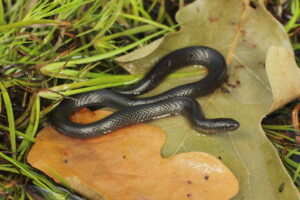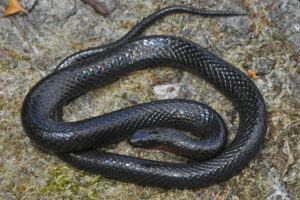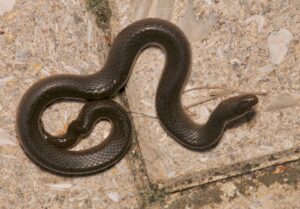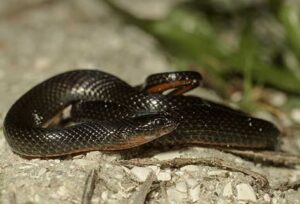The black swamp snake is a shy natricine colubrid endemic to the southeastern US. Other common names of the species are black swampsnake, swamp snake, red-bellied mud snake, and mud snake. The fairly small, thin, and shiny snake is highly aquatic. The females are longer and heavier-bodied than the males, but the males have thicker tails.
Scientific Classifications
- Suborder:Serpentes
- Family:Colubridae
- Genus:Liodytes
- Species:L. pygaea
Conservation Status
Subspecies
This snake has three recognized subspecies.
- South Florida swamp snake (Liodytes pygaea cyclas)
- Carolina swamp snake (Liodytes pygaea paludis)
- North Florida swamp snake (Liodytes pygaea pygaea)
Description
Size
The colubrid is usually 10-15 in (25-38 cm) long, including its tail. The maximum recorded size is 22 in (55 cm).
Color and Appearance
The swamp snake has a uniformly black dorsum with a red or bright orange belly. It has smooth scales, and the head is not much wider than the neck.
Are They Dangerous to Humans
The non-venomous, secretive snake is typically of a docile nature. If harassed, it vibrates its tail rapidly. When captured, it releases a foul-smelling musk from glands at the base of its tail but rarely bites in defense.
Black Swamp Snakes at a Glance
Distribution
It can be found in Georgia, North Carolina, South Carolina, Florida, and Alabama on the eastern coast of the US.
Habitat
The almost entirely aquatic black swampsnake prefers heavily vegetated swampland habitats. It often hides among dense vegetation in tannic cypress swamps.
Lifespan
It lives for near about 7 years in the wild.
Predators
Larger animals like hawks, weasels, and foxes are its predators.
Diet
It eats tadpoles, small fish, salamanders, frogs, amphiumas, sirens, and invertebrates like earthworms and leeches.
Reproduction
Ovoviviparous (gives birth to live young from eggs that hatch inside the body)
Unlike many snakes, the gravid females feed actively, suggesting that they pass the nutrients directly to the offspring. She gives birth to broods of 11-13 in shallow water. The newborns are 4¼-5⅜ in (11-14 cm) long, including their tails.
Source
flickr.com, thehibbitts.net, inaturalist.ca, medianauka.pl









